

Dundas Square
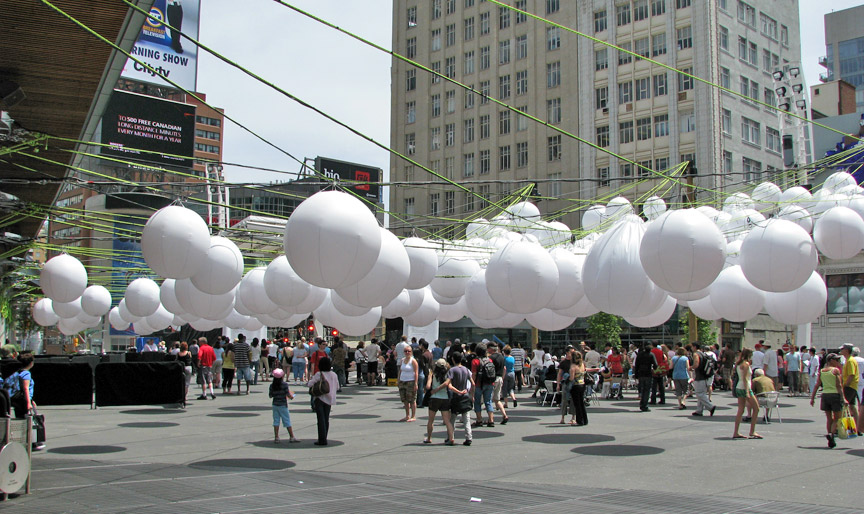
Dundas Square
Yonge-Dundas Square (commonly called Dundas Square) is a public square in downtown Toronto, Ontario, Canada. It is located on the southeast corner of Yonge Street and Dundas Street. It was opened to the public in November 2002, and a "grand opening" concert was held on May 30, 2003.
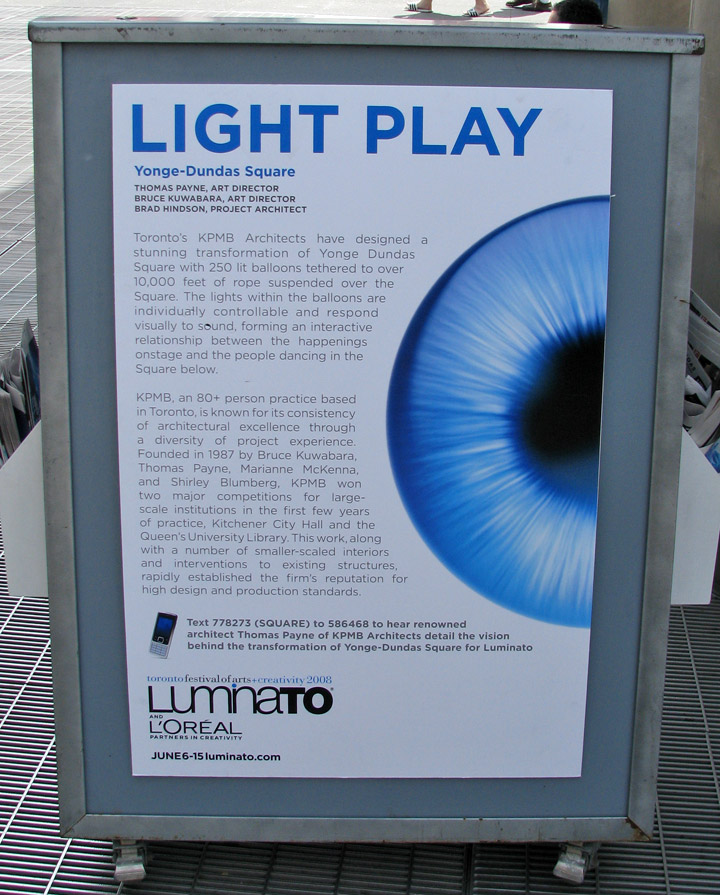
Luminato
Because Dundas Street bends at the square, a triangular portion is chopped off one side, so the shape of the square is actually like a square with a triangle taken out of one side. This northern side of the square that runs at an angle is known as the hypotenuse, which features a structure supported by 11 concrete pillars of the type used to make overpasses on highways. This creates an industrial urban aesthetic, which, being to the north, casts no shadows on the rest of the space. The other three sides are square (i.e., at right angles to one another and to Yonge Street and Dundas Street West).
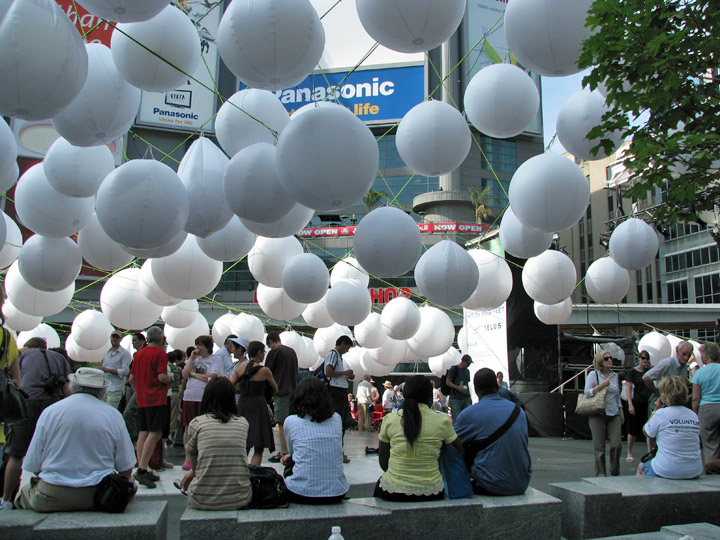
Designed by Brown + Storey Architects, the square was intended as a new public
space in Toronto, somewhat akin to Nathan Phillips Square, designed by Viljo
Revell for New City Hall. Unlike Nathan Phillips Square, however, Yonge-Dundas
Square is operated as a commercial venture, with a separate Board of Management.

Until the late 1990s, the Yonge-Dundas Square site was occupied by a block of
retail stores, and considered by many to be a "seedy" or dangerous corner. In
1998, as part of its Yonge Street Regeneration Project, Toronto City Council
approved the expropriation and demolition of the buildings on the site, and the
construction of Dundas Square.
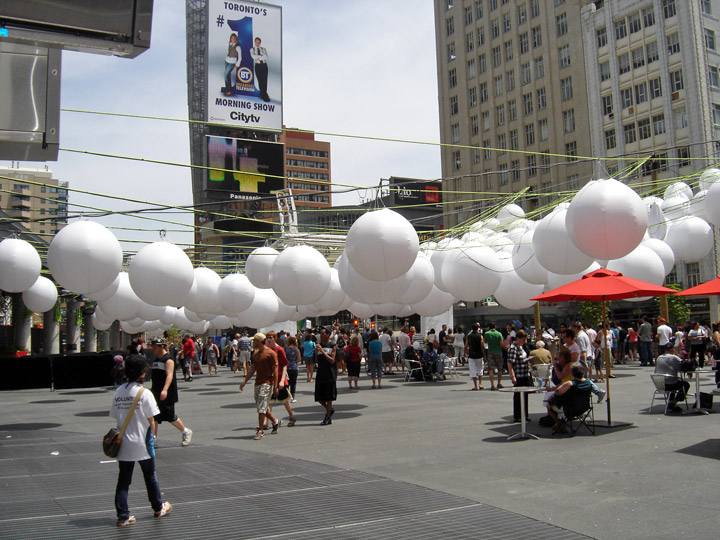
The square is opposite the Toronto Eaton Centre and just south of the Ryerson
University campus, and is part of a historic revitalization effort by the city,
residents and the Downtown Yonge Business Improvement Area, an association of
local businesses. This effort was spearheaded by Councillor Kyle Rae, Mr. Robert
Sniderman of the Senator Restaurant and Mr. Arron Barberian of Barberian's Steak
House. In late 2007, the Toronto Life Square entertainment complex opened across
the street from the square.
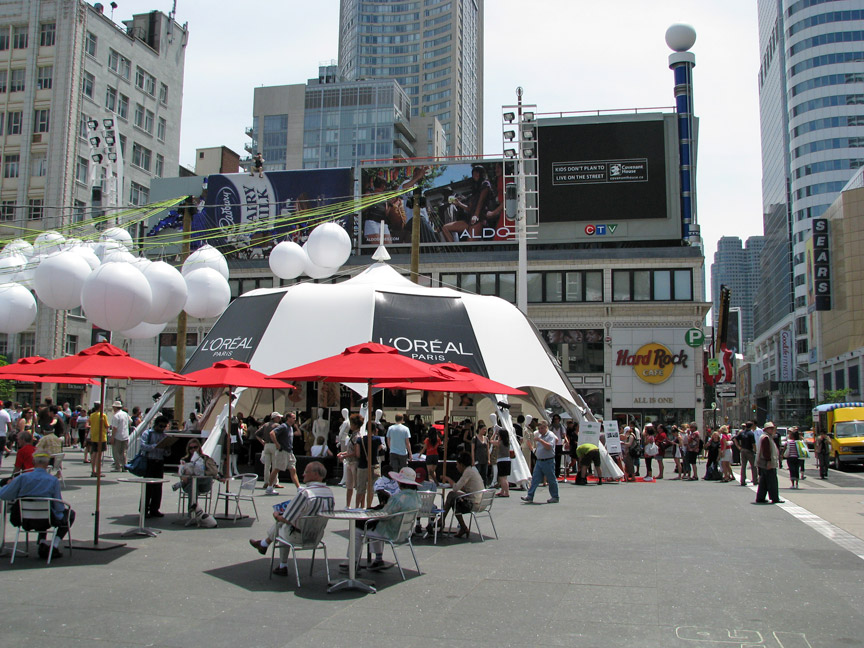
Hard Rock Cafe on Yonge-Dundas Square
More Photos of the Hard Rock Cafe
The square is actually on a slight incline, which architects Brown and Storey have said was intended to evoke a theatrical stage. It is made with modular raised square textured 35.125 by 35.125 inch (892 by 892 mm) granite slabs (each slab costing approx. $1500: $1,000 materials plus $500 labor), features a diagonally running zinc canopy along the northern hypotenuse of the "square", a movable plinth which serves as a stage for concerts and other performances, a row of lighted fountains set directly into the pavement, a row of small trees along the southern edge, a transparent canopy over the plinth, and a new entrance to Dundas subway station below. A series of low, circular stone planters was added to the western side of the square in summer 2005.
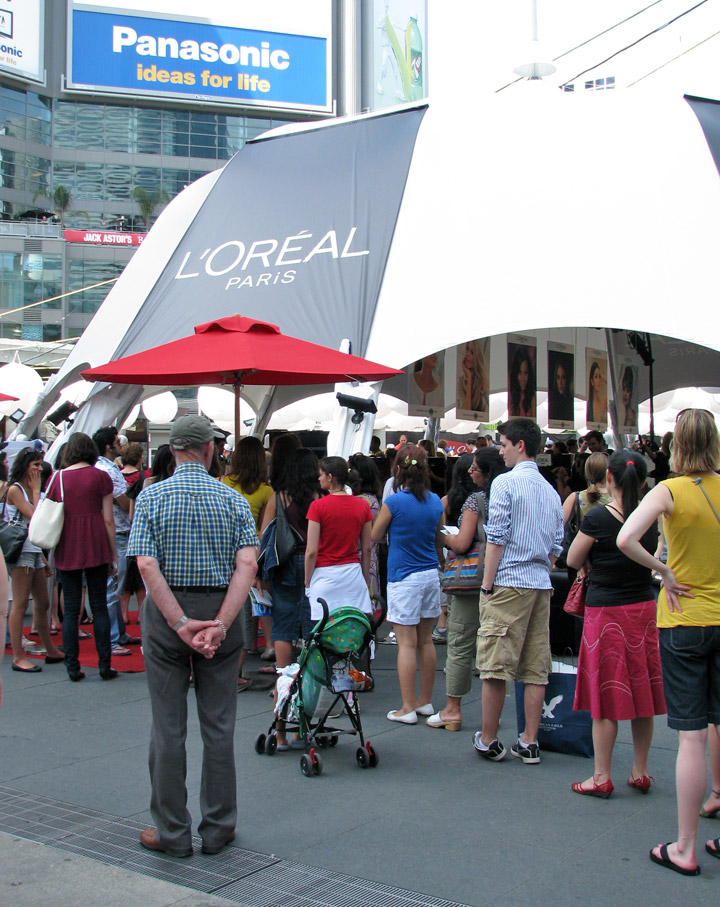
in line for the L'Oreal makeover
The granite slabs, made of two kinds of granite, modularize the space, with a period of seven slabs (every seventh slab has a slightly different texture and darkness). This period intertwines with the five-slab periodicity of the splash fountains, with a spatial period of 177 inches (4.5 m) (one splash fountain every five slabs), making a mathematically intricate space.

The centerpiece of the square is the array of fountains designed by Dan Euser of
Waterarchitecture. Two rows of ten fountains are spread out across the main
walkway of the square, so that visitors have the opportunity to walk through or
around the fountains. Unlike many other city fountains, the Dundas Square
fountains were meant for waterplay, and include a sophisticated filtration
system that, according to both of the architects, keeps the water at or above
"pool quality" water. According to Euser, the water is treated to maintain
health standards for water play. According to facility administrator Christine
MacLean, the slate that was chosen for the entire space has nonslip properties
for the safety of persons running through or playing in the fountains. Each of
the ten water fountains consists of a stainless steel grille with 30 ground
nozzles (arranged in three rows of ten) under it.
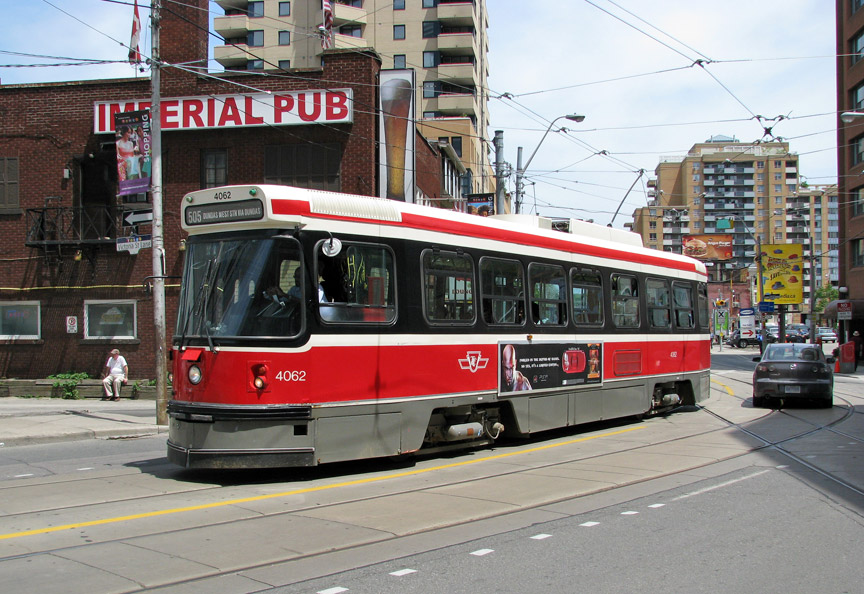
505 Streetcar at Dundas Aquare
As well, there is a road which traverses the square known as Dundas Square. This
is a small street leading from Yonge St. to Dundas St.
Yonge-Dundas Square is located within the Downtown Yonge Business Improvement
Area (BIA). City of Toronto councillor Kyle Rae has pointed to Times Square in
New York City as a model to emulate, with its canyon of billboards and animated
advertising screens.

sightseeing from Dundas Square
Other projects in the immediate area include the redevelopment of the Eaton Centre, the construction of a new retail and cinema complex to the north, called Toronto Life Square (and formerly known as "Metropolis"), and the construction of 35 Dundas Street East to the south-east (on the corner of Victoria and Dundas), formerly the home of Olympic Spirit Toronto. On October 22, 2007, Rogers Media announced that it will buy this building as a new home for its Citytv and OMNI Television stations.
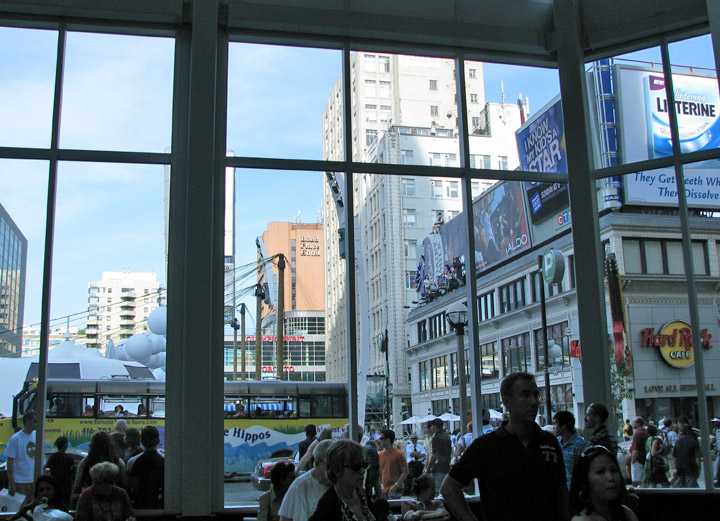
Dundas Square as seen from Eaton Centre
A "Media Tower" - essentially a scaffold for billboards, operated by Clear
Channel Communications - has been constructed on the north-west corner of Yonge
and Dundas. It is considered to be the tallest media tower in the world. Another
large media tower complete with video screen is a major feature of the building
on the south-east corner of Dundas Square. And the building which is home to the
Hard Rock Cafe on the south-west corner of the square also features a series of
billboards and a large video screen. The introduction of these imposing media
towers and their brightly illuminated advertising billboards has been too great
a sacrifice for some area residents, who feel a loss of the neighborhood's
identity and character.
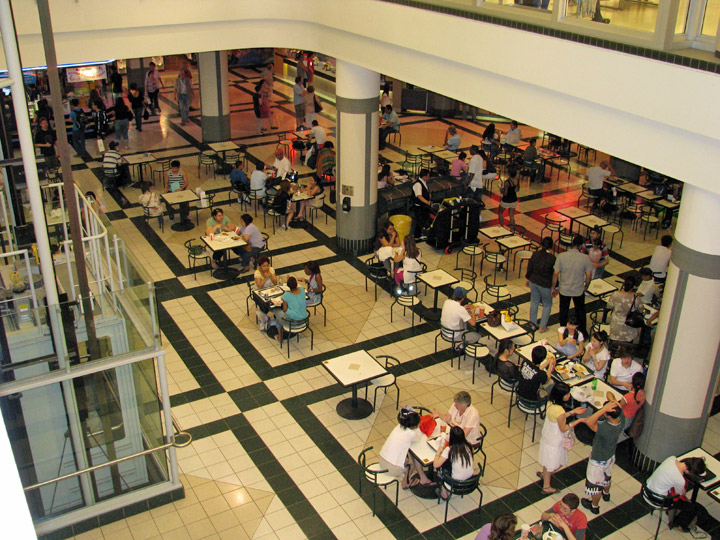
Food Court of Eaton Centre
The redevelopment of the Eaton Centre and the building at Victoria and Dundas were both completed in 2004. Toronto Life Square (formerly known as the Metropolis development), began in January 1999 after the City of Toronto expropriated a number of properties. Following a number of delays (including some construction shutdowns) the project is nearing completion and the developer, PenEquity Management Corp., currently plans a Phase I opening in 2007.
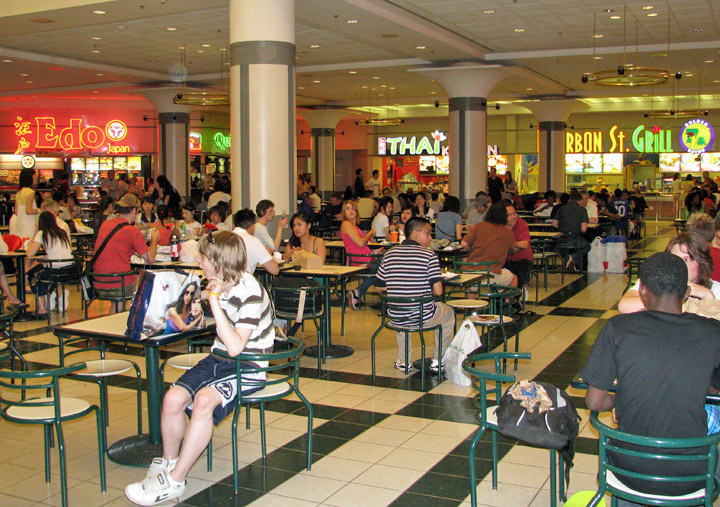
Architectural glass brick is used to obscure clear visual line of sight into
women's washroom/changeroom on the left, and men's on the right. The glass
brick, however, admits light, and the labyrinth design allows for unobstructed
passage of air, as well as barrier-free accessibility. Additionally, inside the
washrooms, glass brick windows run around the entire perimeter, near the top of
the wall, to create "natural artificial light" by way of light bulbs shining in,
but located in the service/utilities area that runs all the way around outside
the washrooms. The result is an underground space that is transformed into a
space that appears to be naturally illuminated.
Architectural glass brick is used to obscure clear visual line of sight into
women's washroom/changeroom on the left, and men's on the right. The glass
brick, however, admits light, and the labyrinth design allows for unobstructed
passage of air, as well as barrier-free accessibility. Additionally, inside the
washrooms, glass brick windows run around the entire perimeter, near the top of
the wall, to create "natural artificial light" by way of light bulbs shining in,
but located in the service/utilities area that runs all the way around outside
the washrooms. The result is an underground space that is transformed into a
space that appears to be naturally illuminated.
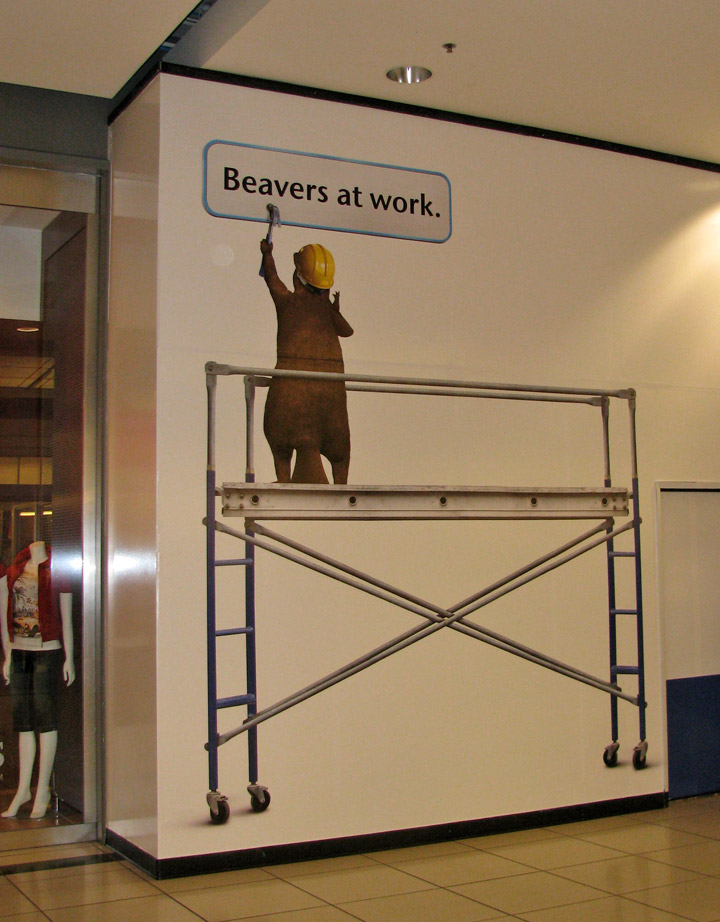
The surface of Yonge-Dundas Square is not level, because it is sloped upward as
the surface goes away from Yonge Street. This is to allow sufficient height to
provide clearance for the Toronto Parking Authority garage entrance. The
architects planned the surface's slope to make it interesting and to accommodate
the necessary clearances for what lies under the Square. Additionally, level P1
houses the washrooms/changerooms, green room (for stage performers), and various
utilities rooms, custodial and supply closets, as well as the water treatment
plant and pump rooms for the fountains.
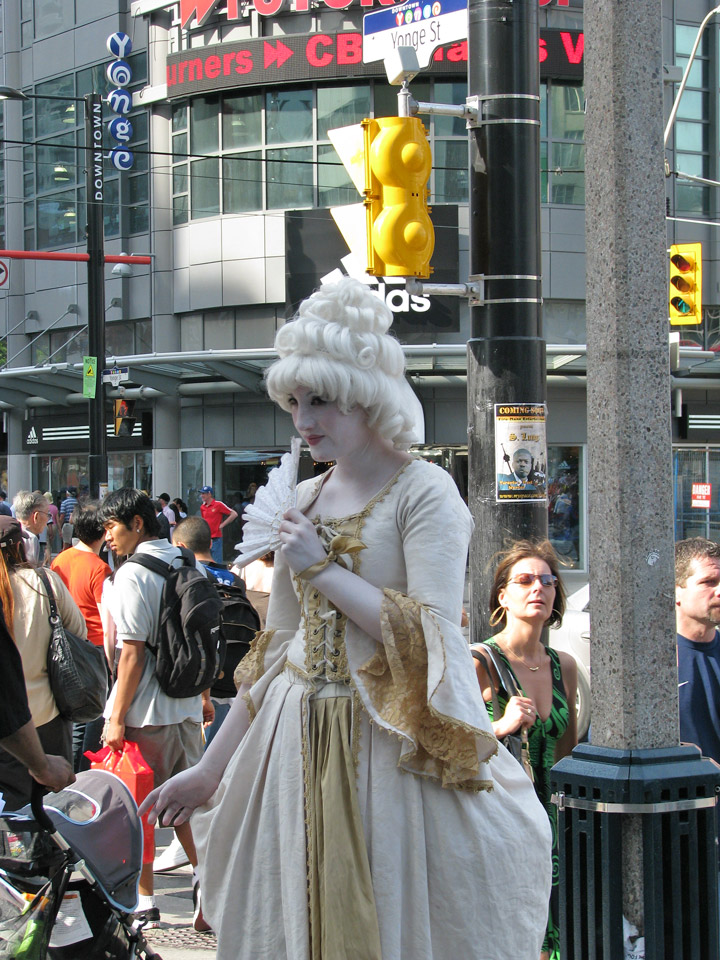
mime
Yonge-Dundas Square is controversial in some circles. Criticism ranges from
suggestions that the city has missed an opportunity for more green space within
the downtown core (or that they have missed an opportunity for what some critics
consider more interesting architectural elements) to questions of what the true
intent behind the ostensibly public square is. A number of groups, from the
Toronto Public Space Committee, to organizers of Toronto iterations of the
Reclaim The Streets phenomenon, often point to the Square as exemplifying what
they consider a negative trend in urban planning.
The square is surrounded on all sides by gigantic commercial billboards; with
city funds going towards what appears to be a large re-development experiment,
many have pointed to the square as a prime example of the creeping privatization
of public space. Those making this point have been bolstered by the fact that
the square's board is populated by both local businesses and residents. The
Board of Management for the Square is an ABC organization of the City of
Toronto. While there are permit fees for commercial events, community groups can
use the Square for free under the Square's Community Use Policy. All events are
charged back for staffing and equipment use.
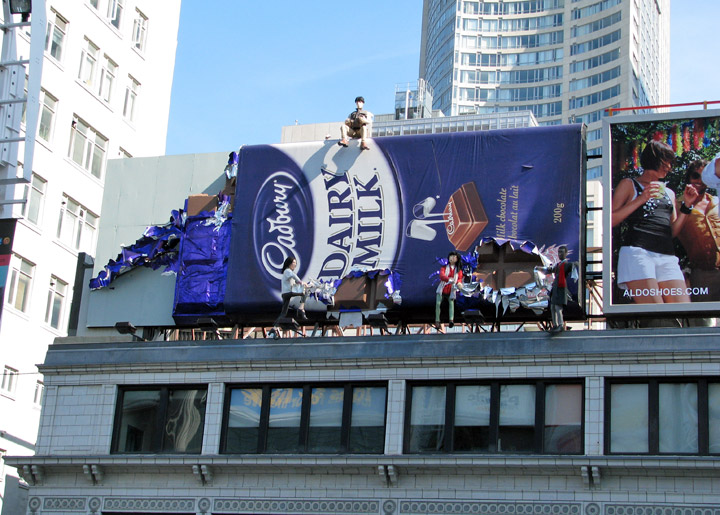
Cadbury Billboard
On an aesthetic note, some detractors have said that when the fountains are not
running (e.g., to mask out the sounds of traffic), the square feels like a GO
transit commuter bus station or an abandoned parking lot. Some suggest it should
have monuments or other items (such as greenery) to break up the open space.
However, the main problem is often said to be the simple lack of people. This
has been improving with the addition of regular special events including
lunchtime jazz concerts and outdoor film screenings. When events are not taking
place, the Square is set with cafe tables, chairs and umbrellas.
On March 15, 2006 sections of the signage on the Eaton Centre side of the square
came loose falling onto pedestrians. High winds reaching speeds of 120 km/h (75
mph) caused sections of the billboard to fall more than fifteen stories to the
ground. Police closed Yonge Street until the signage could be secured. One man
in his 20s suffered severe head injuries from the falling debris.
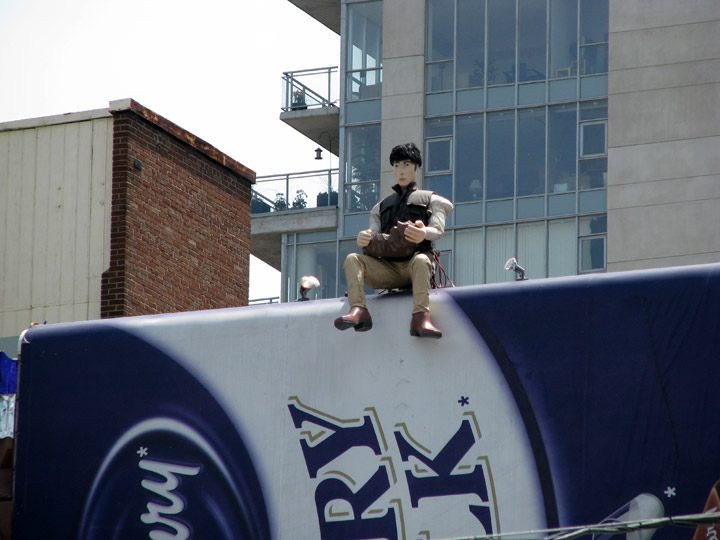
eating chocolate
One of the three rows of ten nozzles that are present in each of the 20
fountains. A fisheye lens was used so that we can see at least some of the
nozzles in close detail, yet still be able to see and count all 10 of them. The
nozzles are spaced 2 inches (approx. 50 mm) apart within each row, and the rows
are spaced 3 inches (approx. 75 mm) apart.
One of the three rows of ten nozzles that are present in each of the 20
fountains. A fisheye lens was used so that we can see at least some of the
nozzles in close detail, yet still be able to see and count all 10 of them. The
nozzles are spaced 2 inches (approx. 50 mm) apart within each row, and the rows
are spaced 3 inches (approx. 75 mm) apart.
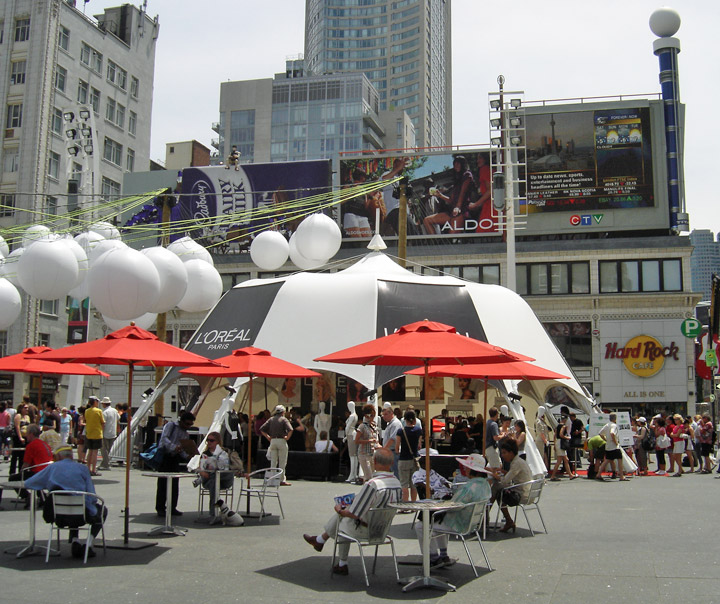
during luminato
The width of the water spray is always 6 inches (152 mm) wide, the three rows of ten are each 3 inches (76 mm) apart, and 18 inches (457 mm) broadside, because the nozzles in each row are spaced 2 inches (51 mm) apart. This 18 inch (457 mm) width was selected to match the width of the widest of adult human users. The height of the spray is time-varying, and under program control. There are various programs for the fountains, the two most common being sinusoidal unison, and westward wave packets. During most of the summer and fall of 2004, all 600 nozzles rose and fell in unison, in a sinusoidally time-varying fashion, with a period of approximately 10 seconds, to create an urban beach effect, as the "waves" or "surf" pounds against the hard rock surface. The water goes from approximately 1 foot (300 mm) high, to 8 feet (2.4 m) high, giving rise to a peak-to-peak sinusoidal amplitude of 7 feet (2.1 m). Starting on Thursday, 27 October 2004, the program was changed to one that sends wave packets westward, with a period of approximately 8 seconds across all 10 fountains (but only the middle channel of each one, with the westward channels forming a background pedestal). This period gives rise to a phase velocity of approximately 5.6 meters per second. Running westward at a moderate speed (i.e. approximately 20 km/h), one can stay inside the peak of the wave packet, to get a very enjoyable waterplay experience, when the wave packet program is running in the fountains.
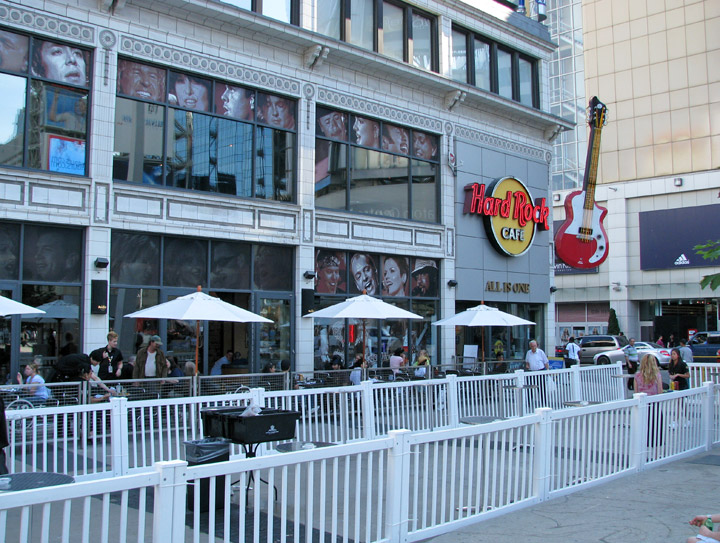
after
The fountains are intended to appeal to children and adults alike, and there is
evidence that this intention has been realized:
Meanwhile, nearer Yonge Street, by the splash pad (a series of fountains
designed to allow people to cool off in their spray), a group of men in their
early 20s laughing and speaking Portuguese tried to wrestle each other into the
spray.

from 10,000 BC
Architects Brown and Storey, the creator of the fountains (Dan Euser), the firm that initiated the bidding, Councillor Kyle Rae, and the management of Dundas Square have all confirmed that waterplay was one of the intended uses of the space.
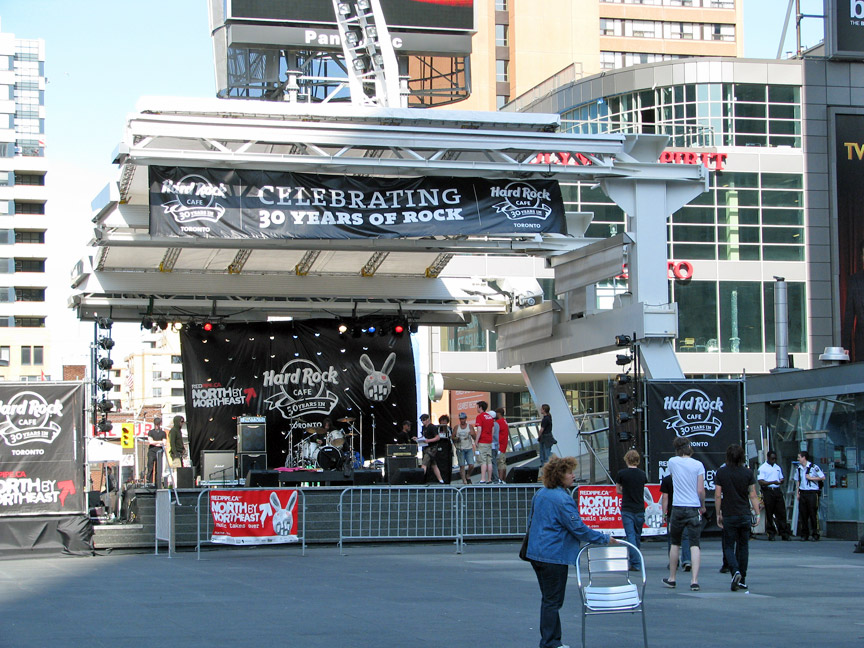
The entire rock surface is of a very dark (almost black) color, and effectively
absorbs sunlight, thus creating a warm surface to rest on. The water runs under
the dark rock slabs, and is thus heated by them, so that the fountain water is
solar heated.
Three curved lighting masts along the south edge of the urbeach, made of hollow
structural steel have a high gloss white finish that contrasts with the rough
nonslip texture of the black granite, and each support six mercury vapor arc
lamps that create evening light that comes from approximately the same
directions as natural sunlight does during the day (i.e. from various southerly
directions).

next attraction
At the Southeast and Southwest corners of Yonge-Dundas Square there are drinking water fountains. The water fountain on the Southwest corner (nearest to Yonge Street) is known for its large, cool stream of water that flows down the fountain to drains in the ground. The stream produced by the other fountain is warmer and flows less copiously. On the other hand, the fountain nearest Yonge street is also near a protrusion in the ground that people like to sit on. This makes it very awkward to get a drink out of this fountain since often a person is sitting right in front of where one would get a drink. This is especially awkward since the stream produced by this fountain is big, making getting a drink a cool, refreshing experience, but also resulting in somewhat of a messy experience that one would not want a stranger to view.
Text from Wikipedia